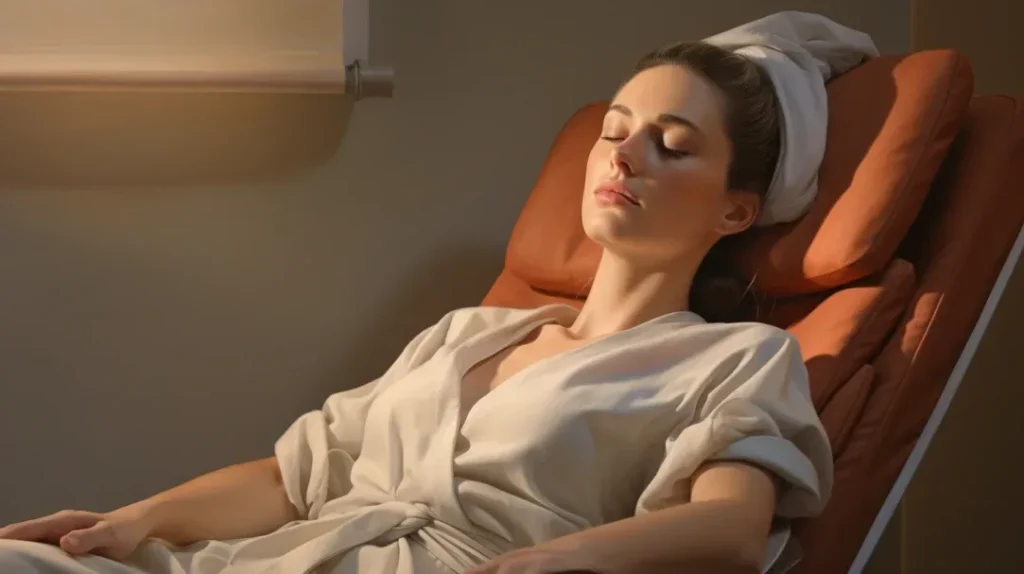Botox Aftercare: What to Expect Afterwards
Are you considering getting Botox injections? If so, knowing what to expect afterward for a smooth recovery and optimal results is essential.
This article will guide you through essential aspects of Botox aftercare. Imagine your face as a canvas and Botox as the delicate brush strokes that enhance your natural beauty. But just like a painting needs proper care to last, your face needs post-treatment care, too.
Learn how to ensure a smooth recovery and long-lasting results.
Key Takeaways
- Botox aftercare is essential for successful cosmetic treatment and patient satisfaction.
- The trend in cosmetic procedures, including Botox, focuses on minimally invasive techniques and natural-looking results.
- Factors such as dosage, injection technique, and individual skin types influence the duration and effectiveness of Botox.
- Follow-up appointments are crucial in maintaining the desired aesthetic results after Botox treatment.
Immediate Post-Botox Care
Post-botox care is crucial for maximizing the treatment’s benefits and minimizing potential side effects. Here are essential guidelines for immediate aftercare following a Botox injection:
- Avoid Touching or Rubbing the Treated Area:
- Risk of Spreading: Touching or rubbing can spread the Botox to unintended areas, altering its effects.
- Gentle Care: Be gentle with the treated area, especially when washing your face or applying skincare products.
- Use Cold Compresses or Ice Packs:
- Reducing Swelling and Bruising: Applying a cold compress can help minimize any swelling or bruising post-injection.
- Application Method: Gently apply the compress for short intervals, taking care not to apply excessive pressure.
- Limit Physical Activity:
- Avoid Strenuous Exercise: Refrain from intense physical activities for at least 24 hours to prevent increased blood flow to the face.
- Stay Cool: Avoid saunas, hot showers, or activities that significantly raise your body temperature.
- Moderate Alcohol and Heat Exposure:
- Alcohol Consumption: Avoid alcohol as it can increase the likelihood of bruising and swelling.
- Heat Exposure: Steer clear of direct sunlight and heat for 24 hours to reduce the risk of swelling.
- Pain Management:
- Over-the-Counter Medication: If you experience discomfort, consider taking pain relievers like acetaminophen. Avoid NSAIDs like ibuprofen, as they can increase bruising.
- Adhere to Specific Instructions:
- Provider’s Advice: Follow any tailored advice from your healthcare provider, including recommendations on facial exercises or skin care product restrictions.
- Hydration and Healthy Lifestyle:
- Stay Hydrated: Drinking plenty of water helps in the recovery process.
- Healthy Diet: Maintaining a balanced diet supports overall skin health and recovery.
- Monitor for Side Effects:
- Observe Changes: Watch for any unusual side effects and inform your healthcare provider if they occur.
By following these immediate post-botox care tips, you can help ensure a smoother recovery and better results from your treatment. Remember, each individual may have specific needs, so it’s essential to consider any personalized instructions your healthcare professional provides.
Managing Common Side Effects

Effectively managing common side effects of Botox is vital to a comfortable recovery and ensuring the best possible results. Here are some strategies to handle these side effects:
Managing Redness, Swelling, and Bruising:
- Cold Compresses or Ice Packs:
- Application: Apply cold compresses or ice packs to the treated area to reduce swelling and soothe redness.
- Duration: Do this intermittently during the first 24 hours post-treatment.
- Avoiding Heat Exposure:
- Activities: Steer clear of hot environments like saunas, steam rooms, or hot showers for at least 24-48 hours.
- Sun Exposure: Minimize direct sun exposure and use sunscreen to protect the treated areas.
- Elevating the Head:
- Sleeping Position: Keep your head elevated for the first night to help reduce swelling.
Managing Mild Discomfort:
- Over-the-Counter Pain Relievers:
- Medication Choice: Use acetaminophen if needed for pain relief. Avoid NSAIDs like ibuprofen, as they may increase bruising.
- Gentle Care:
- Skin Products: Be gentle when applying skincare products or makeup to avoid further irritation.
Avoiding Certain Activities:
- Physical Activity: Refrain from strenuous exercise or activities that increase blood flow to the face for at least 24 hours.
- Touching the Area: Avoid rubbing or massaging the treated area to prevent the spread of Botox to other muscles.
If Touch-Up Treatments Are Needed:
- Consultation: If results differ from what iscted, consult your healthcare provider. They may recommend touch-up treatments to fine-tune the results.
- Timing: Usually, it’s advisable to wait for a certain period before undergoing touch-ups to allow the initial treatment to take effect fully.
Prioritizing Safety:
- Professional Advice: Always follow the aftercare instructions provided by your healthcare professional.
- Monitoring: Keep a close watch on your recovery and report any unusual or prolonged side effects to your provider.
By taking these proactive steps and adhering to the aftercare advice, you can effectively manage common side effects and enhance your overall Botox experience. Individual responses to Botox can vary, so personalized care from your healthcare provider is essential.
Enhancing Botox Longevity
It’s important to incorporate certain practices into your aftercare routine to maximize the longevity of your Botox results. Here are some tips to enhance the effectiveness of your Botox treatment:
- Follow a proper skincare routine after Botox, including gentle cleansing and moisturizing.
- Avoid excessive touching or rubbing of the treated area to prevent the spread of the toxin.
- Avoid activities that may increase blood flow to the face, such as intense exercise or saunas.
- Adhere to any specific instructions your healthcare professional provides regarding post-treatment care and follow-up appointments.
- Be mindful of the healing process and understand that seeing the full aesthetic results may take some time.
Follow-Up Appointments and Maintenance
Regular follow-up appointments and maintenance are integral parts of the Botox treatment journey, helping to sustain your desired aesthetic results and ensure ongoing effectiveness. Here’s a closer look at the importance of these aspects:
Follow-Up Appointments
- Monitoring Progress:
- Assessment: Your healthcare provider will assess how your muscles respond to the treatment.
- Addressing Concerns: This is an opportunity to discuss any side effects or concerns you may have post-treatment.
- Evaluating Results:
- Satisfaction Analysis: Your provider will evaluate the cosmetic results, ensuring they align with your initial goals.
- Adjustments: Minor adjustments or touch-ups can be made during these appointments if necessary.
- Longevity of Results:
- Duration: Typically, Botox results last between 3 and 6 months, but this can vary based on individual factors.
- Planning Next Steps: Discuss the ideal frequency of treatments to maintain your desired look.
Regular Maintenance Appointments
- Continuity of Care:
- Consistent Visits: Regular appointments help in maintaining a consistent aesthetic appearance.
- Treatment Adjustments: Over time, your treatment plan might need adjustments based on how your body responds to Botox.
- Personalized Care:
- Tailored Approach: Regular visits allow your provider to refine treatments based on your evolving needs and preferences.
- Holistic Approach:
- Overall Wellness: These appointments can also be a time to discuss broader skincare and wellness routines that complement Botox treatments.
Holistic Approaches to Botox Aftercare
- Skincare Routine:
- Gentle Products: Incorporate gentle, non-irritating skincare products to enhance overall skin health.
- Sun Protection: Use sunscreen to protect the skin and maintain the treatment results.
- Healthy Lifestyle:
- Diet and Hydration: A balanced diet and adequate hydration can support skin health.
- Stress Management: Techniques like yoga or meditation can help maintain the relaxing effects of Botox on facial muscles.
- Long-Term Care:
- Skin Health: Consider treatments like facials or other non-invasive procedures that support long-term skin health.
By prioritizing follow-up appointments and adopting a holistic approach to aftercare, you can maintain the effects of your Botox treatment and enhance your overall facial health and well-being. Remember, your healthcare provider is your partner in this journey, offering guidance and tailored care to ensure the best possible outcomes.
Holistic Approaches to Botox Aftercare
Incorporating holistic approaches into your Botox aftercare regimen can significantly enhance the treatment’s effectiveness and overall well-being. Here are some holistic methods to consider:
Facial Exercises
- Promoting Circulation: Gentle facial exercises can help improve blood circulation to the face, promoting healing and skin health.
- Muscle Tone: Regularly engaging in these exercises might improve muscle tone, complementing the effects of Botox in wrinkle reduction.
Adhering to Patient Guidelines
- Follow Professional Advice: Adhere strictly to the aftercare instructions provided by your healthcare provider to ensure optimal healing and results.
- Activity Restrictions: This might include guidelines on physical activities, facial movements, or skincare routines post-treatment.
Health and Wellness
- Balanced Diet: A diet rich in antioxidants, vitamins, and minerals can support skin health and aid recovery.
- Hydration: Staying well-hydrated is essential for maintaining skin elasticity and overall health.
- Regular Exercise: Moderate exercise can boost circulation, improving overall health and well-being.
- Adequate Sleep: Quality sleep aids in the body’s natural healing processes and can improve the longevity of Botox results.
Stress Management
- Relaxation Techniques: Practices like yoga, meditation, or deep breathing exercises can help manage stress, which can otherwise impact skin health.
- Mind-Body Connection: Cultivating a positive mindset can contribute to a more satisfactory outcome and overall experience.
Skincare Routine
- Gentle Products: Use skincare products that are gentle and non-irritating to support the treated areas.
- Sun Protection: Protect your skin from sun damage, as UV exposure can accelerate aging and affect Botox results.
Regular Skincare Treatments
- Complementary Therapies: Consider treatments like facials or microdermabrasion that support skin health without interfering with Botox.
- Consultation: Always consult your healthcare provider before introducing new treatments or products to your routine.
By adopting these holistic approaches, you enhance the results of your Botox treatment and contribute to your overall facial health and well-being. Holistic aftercare focuses on treating the whole person, not just the treated areas, for a more fulfilling and effective rejuvenation journey.
Frequently Asked Questions
Can I Wear Makeup Immediately After Getting Botox?
Yes, you can wear makeup immediately after getting Botox. However, it is recommended to wait for a few hours to avoid touching or rubbing the injection sites. Be gentle when applying makeup to ensure proper healing.
How Soon Can I Resume My Skincare Routine Botox Aftercare Injections?
You can resume your skincare routine the day after Botox injections. However, avoid massaging or applying pressure to the treated area to prevent complications or interference with the Botox settling correctly.
Is It Normal to Experience Numbness or Tightness in the Treated Area After Botox?
Feeling numbness or tightness in the treated area after Botox is normal. This sensation is like wearing a snug glove that will gradually fade as the Botox takes effect.
Can I Exercise or Engage in Strenuous Activities Right After Receiving Botox?
You should avoid exercising or engaging in strenuous activities immediately after receiving Botox. This will help ensure optimal results and minimize the risk of complications. Give your body time to heal and follow your provider’s aftercare instructions.
Are There Any Specific Foods or Supplements I Should Avoid After Getting Botox?
After getting Botox, it’s best to avoid foods or supplements that thin your blood, like alcohol or certain pain relievers. These can increase your risk of bruising. Stick to your doctor’s guidelines for a smooth recovery.
Conclusion
In conclusion, properly caring for your skin after receiving Botox injections is crucial for optimal results.
You can ensure a smooth recovery and long-lasting effects by following the recommended aftercare instructions, managing any common side effects, and attending follow-up appointments.
So, unleash your inner glow and embrace the transformative power of Botox – it’s like a magic wand for your skin!







